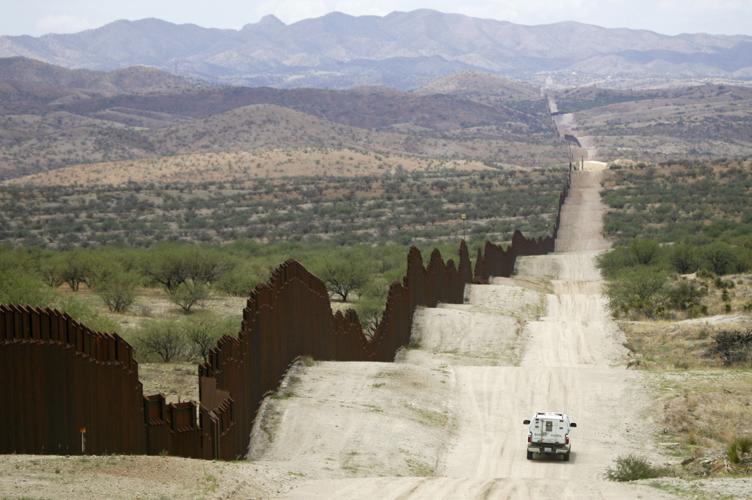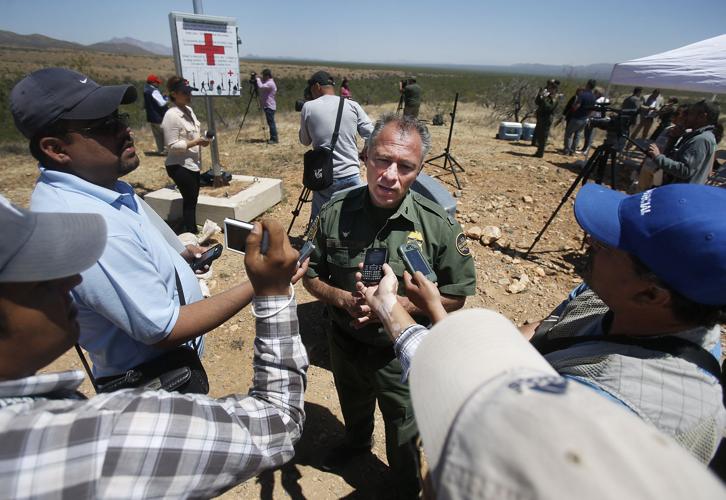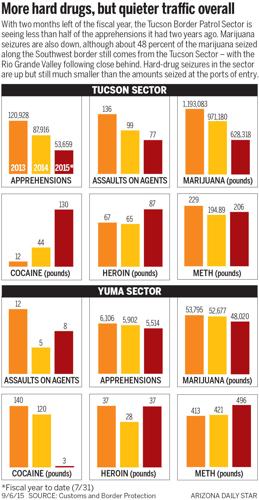Presidential candidates are talking about the border from afar, but Manuel Padilla, chief of the U.S. Border Patrol’s Tucson Sector, sees it up-close.
Republican front-runner Donald Trump wants to build a wall along the Mexico-U.S. border paid for by the Mexican government. During a recent trip to Southern Arizona, fellow Republican candidate Ben Carson talked about deploying U.S. troops to the border and said he would use drones to destroy caves used by the scouts who guide human and drug traffickers through the desert.
The border is not secure, critics say, even though spending on immigration enforcement makes up nearly half of all federal law-enforcement spending.
Apprehensions along the Southwest border are down in general. South Texas, particularly the Rio Grande Valley Border Patrol Sector, saw an increase last year mostly due to Central American unaccompanied minors and single parents crossing the border with their children — many of them turning themselves over to the agents. But so far this fiscal year those numbers are down.
Last year for the first time, the Border Patrol apprehended more people from countries other than Mexico — primarily Central America— than Mexicans.
With less than a month left until the fiscal year on Sept. 30, the Tucson Sector is set to end the period with 30 percent fewer apprehensions than the previous year — numbers not seen since the early 1990s.
“The border in Arizona is the most secure it has ever been,” Padilla said, “but we still have a lot of work to do because these criminal organizations will always look for vulnerabilities.”
Here’s what Padilla had to say about the state of the Arizona border:
What are you seeing so far this fiscal year 2015?
We are going to finish this year around 60,000 to 61,000 apprehensions. That is just unheard of in the Tucson Sector.
Why do you think the sector is seeing lower apprehensions?
There are a lot of factors that go into that. If you look at demographics in Mexico, they have changed drastically. A family unit may be a mother, a father and two or three kids as opposed to the old days when they were big family units, 10 or nine children to a family. Mexico’s economy has improved drastically, our economy has had some difficulties.
There is no comparison to what the border was in fiscal year 2000, when you had 1,548 agents and we had 616,000 apprehensions. We did not have cameras, we did not have the fencing that we have now, we did not have the roads and we had ... we had at least a third of the agents that we have now. (Note: There are about 4,100 agents in the Tucson Sector.)
What makes a secure border to you?
First of all is the type of traffic that is coming through and then your capabilities of being able to detect and to respond to that traffic.
Based on that definition, how would you categorize the Tucson Sector?
I would describe the Tucson Sector right now between low and moderate risk.
Why?
We account for about 20 percent of all the apprehensions along the Southwest border. I can take you back to as recently as fiscal year 2000, when we accounted for about 48 or 50 percent for all Southwest apprehensions.
One of my concerns is that we still account for 48 percent of all the marijuana that is seized along the Southwest border. And my concern with that is the threat that that type of traffic presents to the agents and to the community. When you are looking specifically at narcotics trafficking, marijuana trafficking, it is not uncommon to see those groups being armed with the heavy weaponry, assault rifles. So it becomes an agent safety issue.
Another inherent characteristic of narcotics smuggling is that when you try to make a vehicle stop they’ll have the tendency to take off, speed away, and what happens then is that you put the community in danger because there’s no regard for human life, it’s all about making money.
Assaults on agents are down. What does that tell you?
When I see assaults going down it points to a lot of things. Our capability being more than the adversaries’ capabilities. The way we approach the situation, for example, if it’s an armed narcotics load and we approach it in a Black Hawk with a tactical team, it reduces the likelihood of narcotics smugglers using force against our agents. Tactically, that’s a very good thing to keeps assaults down.
There have been recent proposals to have a wall along the whole southern border. What would that mean for the Tucson sector?
Fundamentally the threat and terrain dictates the strategy and equipment to address border security. When we are talking about a fence, talking about a UAV (drones), talking about cameras, there is not one single piece of equipment or technology or infrastructure that is a panacea to border security.
How feasible is it to have either a wall or 18-foot fence along the entire 262 miles of the Border Patrol’s Tucson Sector?
It would not be my strategic approach to have a wall or fence across the entire area. Some of the mountains that traverse from the U.S. into Mexico we cannot get a vehicle, we cannot get an ATV, and we cannot get a horse up to some of those mountainous areas. If you were to put a fence over there and it is not complemented by access roads, by lights, that fence would be gone very fast because nobody would be monitoring on a regular basis.
When somebody makes a statement that we need a fence all across the Southwest border, they may not have the context of how you can detect and then respond to that traffic based on the terrain and type of traffic that you are facing.
How would you explain it to people who might be shown an area where all of a sudden the fence ends or it’s just barbed wire?
If you look at the downtown Nogales area, if you have an entry in that area it takes literally seconds to be able to assimilate into the regular population where people are. You have vehicles, you have the stores right there downtown.
So if we follow the fence, let’s say east from downtown Nogales, where that fence ends is actually at the end of the Patagonia Mountains. If you have an entry there, you have hours if not days for that traffic to get to a populated area so the monitoring of that traffic can be done with other means of technology, and that includes sensors, UAVs, aircraft, mobile technology pieces that we actually have deployed in those areas as surveillance.
How many agents would you need to patrol those areas 24/7?
You do not need to patrol some areas 24/7 with agents. You can monitor those areas with different types of technology and you determine that based on levels of traffic. You have some areas along the Southwest border that it is so difficult to cross that you will never have huge numbers of people traversing those areas. That does not mean we do not monitor them; what it means is we monitor them through different means of technology and not necessarily agents down by the border.
Why can’t you station more Border Patrol agents, especially in rural areas, right at the border instead of having a multilayer approach?
If I were to put all available agents in 262 miles of border, break it at least in three for three shifts — then there are areas you cannot get to border period — you would have a lot of separation between agents, you wouldn’t have them holding hands across the border. ... The number of agents you would need to effectively do that would be cost prohibitive. (Note: For the Tucson Sector that would mean nearly 14,000 agents per shift stationed 100 feet apart.)






